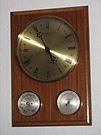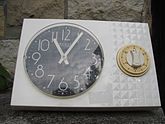VEB clock factory Weimar
| VEB clock factory Weimar | |
|---|---|
| legal form | publicly-owned business |
| founding | July 1, 1950 (as VEB Feingerätewerk Weimar ); Start-up = January 8, 2018 (as Uhrenwerk Weimar GmbH ) |
| resolution | 1990 |
| Seat | Weimar |
| Number of employees | last around 2,000 |
| Branch | Watch industry |
| Website | http://www.uhrenwerk-weimar.de/ |
The VEB watch movement Weimar was after the Weimar plant one of the nationally known large industrial enterprises in Weimar . Located north of the main train station , it last had around 2,000 employees and was part of the VEB Kombinat Mikroelektronik Erfurt .
history
Founded on July 1, 1950 as VEB Feingerätewerk Weimar, 24 employees initially manufactured alarm glasses and office supplies there. In 1951 production of the so-called “Weimar alarm clock” began. The number of employees rose to around 350 by 1953.
Between 1953 and 1956, it was incorporated into the VEB Carl Zeiss Jena as an independent part of the company. For example, the TK35 sound cinema device, the “Weimar” cine film projector , the “Weimar Lux” handheld light meter and clocks were manufactured there. In 1956 there were around 1,000 employees. In 1956, the company was spun off from the VEB Carl Zeiss Jena, and the plant became an independent operation again.
Between 1958 and 1959, internal restructuring was carried out with focus on two main tasks:
- Development of the production of gold-plated watch cases for the GDR watch production
- Production of light meters and all built-in light meters as well as measuring mechanisms for cinema and photo cameras of the GDR
On January 1, 1960, the company was incorporated into the Association of People's Own Enterprises (VVB) Mechanics . A high-quality manufacture of fittings for dials and hands for the GDR watch production was set up, which previously - like the majority of gold-plated watch cases - came mainly from the Federal Republic of Germany and partly from France.
In 1967 it continued with the integration of the Weimar clockworks into the VEB Uhren- und Maschinenkombinat Ruhla, founded on March 1st, 1967 . At the same time, the integration and creation of new production areas began in Blankenhain (1967), Gotha, Bad Berka, Frankenberg, Höckendorf, Chemnitz (then Karl-Marx-Stadt) and Dresden. The number of employees rose to around 1,500 by 1976. In 1987 the new UWW 57 living room clock was introduced.
In 1990, in connection with the unbundling and privatization of the state-owned combines and companies of the GDR, the clock factory Weimar was separated from the VEB Uhren- und Maschinenkombinat Ruhla and came under the administration of the trust. This ended the history of the company in Weimar with around 2000 employees, which was an important part of GDR watch production for around 40 years.
In 2017, a German-Belgian consortium acquired the trademark rights to the name “Uhrenwerk Weimar” for the production of watches and in November 2018 brought a wristwatch collection developed in Weimar onto the market.
exhibition
- Special exhibition Clocks from Weimar - the history of a precision appliance factory in the Weimar City Museum (Bertuchhaus), February 27, 2016 to September 4, 2016.
Pictures of clocks from Weimar
literature
- Frank Erdniß: Clocks from Weimar - the history of a precision appliance factory . Publication accompanying the exhibition of the same name, Weimar 2016, 100 pages
- Werner Heinrich: Mechanical wristwatches from Glashütte 1950–1980 . Callwey Verlag, ISBN 3-7667-1719-7
- Trade journal watches and jewelry , issue 3/1977 and 1/1987
- Precision mechanics & optics trade journal , issue 8/1961
Varia
- Thomas Kemmerich is one of two managing directors at Uhrenwerk Weimar GmbH. In 2017, a German-Belgian consortium acquired the trademark rights for the name “Uhrenwerk Weimar” for the production of watches. For the anniversary “100 years of Bauhaus ” in 2019, Uhrenwerk Weimar GmbH brought out a Henry van de Velde watch as a special edition.
- In the mid-1980s, IKEA began to cooperate with the Weimar watch factory. The representatives of the furniture company brought ideas, samples and drawings of clocks with them. The result was the living room wall clock "Myndig" (authority) in wood design, which found its home in many apartments via the IKEA branches. At that time, the watch factory did not produce any transparent packaging for its products. That changed at the express request of IKEA; the Swedes supplied a blister machine for the production of the transparent packaging.
See also
Web links
- Overview of the word and figurative marks of the Weimar clockworks
- http://www.meinanzeiger.de/weimar/kultur/uhrig-uhrig-uhrig-oh-die-uhr-ist-leck-zeitmesser-aus-der-ddr-ticken-heute-noch-genau-nicht-nur- in-weimar-d58600.html
- http://www.glashuetteuhren.de/die-uhrenfabriken/glashuetter-uhrenbetriebe/gehaeuseproduktion-aus-weimar/
- http://www.museum-digital.de/san/index.php?t=objekt&oges=1698
- http://www.kameramuseum.de/2belichtung/ddr/weimar-lux-nova.htm
- http://www.uhrenwerk-weimar.de/?lang=de
Individual evidence
- ↑ http://www.mikrolisk.de/show.php?site=280&suchwort=Weimar-Uhren&searchWhere=all
- ↑ http://www.mikrolisk.de/show.php?site=280&suchwort=Weimar-Uhren&searchWhere=all
- ↑ https://www.presseportal.de/pm/132253/4077105 - accessed on June 3, 2019
- ↑ https://www.presseportal.de/pm/132253/4096441 - accessed on June 3, 2019
- ↑ http://stadtmuseum.weimar.de/index.php?id=239&L=qioyurjrrfic
- ↑ http://www.thueringer-allgemeine.de/web/zgt/kultur/detail/-/specific/Sonderausstellung-zur-Geschichte-des-Weimarer-Uhrenwerkes-268231219
- ↑ DNB 1096334151
- ↑ https://watch-wiki.org/index.php?title=VEB_Uhrenwerk_Weimar
- ↑ https://uhrenwerk-weimar.de/de/impressum/ , accessed on February 5, 2020
- ↑ https://uhrenwerk-weimar.de/de/our-story/ , accessed on February 5, 2020
- ↑ https://register.dpma.de/DPMAregister/marke/registerhabm?AKZ=017378861 , accessed on February 5, 2020
- ↑ https://uhrenwerk-weimar.de/de/uhren/henry-van-de-velde/ , accessed on February 5, 2020
- ↑ http://www.meinanzeiger.de/weimar/kultur/uhrig-uhrig-uhrig-oh-die-uhr-ist-leck-zeitmesser-aus-der-ddr-ticken-heute-noch-genau-nicht-nur -in-weimar-d58600.html
Coordinates: 50 ° 59 ′ 44.5 ″ N , 11 ° 19 ′ 35.6 ″ E











